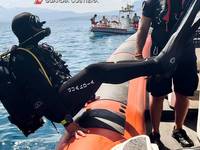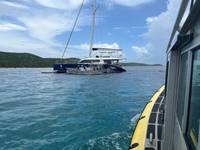Places of Refuge
The concept of force majeure has been broadly accepted since mariners initially encountered the perils of the sea. Persons and governments ashore have been obligated, at least by natural law, to accept and succor those in distress at sea. Concomitant with force majeure is the notion of providing a ship in distress with a place or port of refuge. A place of refuge is where a ship could go to avoid or ameliorate the peril and then depart at the earliest opportunity. While the original need for force majeure and a place of refuge was to reduce the risk to the lives of those on board the ship, the concept naturally extended to the ship itself and any cargo it might be carrying.
Moral and legal support for the concept that a coastal state was obligated to provide, upon a valid force majeure request by a ship master, a place of refuge were lost as a result of two unrelated but nearly contemporaneous events: first, the development and deployment of reliable long-range helicopters for maritime rescue purposes; and second, the grounding of the tanker TORREY CANYON in international waters off the southwest coast of England.
The Sikorsky HH-52A Seaguard helicopter entered into service in 1962. With a speed of 98 miles per hour, a range of 474 miles, the ability to carry up to ten passengers, and the ability to land on and take off from water, it and those helicopters that followed quickly reduced the need to allow vessels to enter a place of refuge if the only risk was loss of life.
On 18 March 1967, the tanker TORREY CANYON, carrying approximately 120,000 tons of crude oil, ran aground in international waters off Land’s End, Cornwall, Britain. The crew was promptly rescued, but the oil started spilling into the sea and washing up on the shores of Britain and France. Under then-existing international law, Britain had no authority to act without the approval of the flag state. Britain did not wait. After fighting the spill unsuccessfully for three days, Britain ordered the Royal Air Force and the Royal Navy to bomb the ship in an attempt to ignite the oil. This technically amounted to an act of war.
Rather than sanction Britain for its actions, the international community retroactively endorsed them by adopting the International Convention relating to Intervention on the High Seas in Cases of Oil Pollution Casualties, 1969 (Intervention Convention). The Intervention Convention establishes a regime within which a coastal nation can take action against a foreign vessel on the high seas threatening to pollute its coasts or its waters. While consultation with the flag State of the vessel and other States that might be affected by the casualty is strongly encouraged, such consultation is not required in an emergency. The coastal State is also encouraged to consult with the owner and operator of the ship, but again this consultation is not required in an emergency. Not only can the coastal state take unilateral action against a ship on the high seas that might pollute its waters, it can prohibit entry into the territorial sea or internal waters. While arbitrary denial of an entry request ( based on force majeure) is discouraged, it is not prohibited – and there is no review mechanism.
On December 30, 2000, the tanker CASTOR was underway in the western Mediterranean Sea en route from Constanza, Romania to Lagos, Nigeria, carrying 29,470 tons of unleaded gasoline. During a fierce winter storm, the ship developed a 22-meter long crack across its main deck between frames 72 and 73, approximately midway along its 183.5 meter length. For the next 24 days, the tanker fruitlessly sought permission to enter sheltered coastal waters of nations littoral to the Mediterranean. Its requests were rebuffed successively by Morocco, Spain, Gibraltar, Algeria, Tunisia, France, Italy, Malta, and Greece. Finally, on January 22, 2001, the cargo remaining on board was successfully lightered during a high seas transfer in international waters near Malta. On February 19, 2001, the CASTOR entered a shipyard in Piraeus, Greece for gas-freeing, inspection, and repair.
The CASTOR incident was the most notorious case of coastal states denying entry and a place of refuge to vessels in distress, but it was by no means isolated. On July 21, 1991, the tanker KIRKI lost its bow in heavy weather while about 24 miles offshore Western Australia. Cargo oil was spilled and fire broke out on board. After the crew was evacuated, a salvage tug put a towline on the tanker. The Australian government initially directed that the tanker be towed further offshore to reduce risk of pollution to coastal waters. After the fire was extinguished, the weather abated, and the situation stabilized, the government allowed the tanker to be brought into sheltered waters where the remaining cargo was lightered. The Government of South Africa has exercised intervention powers on at least two occasions: the WAFRA in 1971 and the VENOIL in 1977. In the WAFRA incident, the tanker was ordered far offshore and then sunk with bombs and depth charges. In the VENOIL incident, the tanker was ordered offshore until oil discharges had been brought under control. Other instances could be added to this list.
In the aftermath of several marine casualties off the coast of Europe, the European Parliament and the Council issued a Directive in 2002 establishing a Community vessel traffic monitoring and information system. Among other things, the Directive provides:
Non-availability of a place of refuge may have serious consequences in the event of an accident at sea. Member States should therefore draw up plans whereby ships in distress may, if the situation so requires, be given refuge in their ports or any other sheltered area in the best conditions possible. Where necessary and feasible, these plans should include the provision of adequate means and facilities for assistance, salvage and pollution response. Ports accommodating a ship in distress should be able to rely on prompt compensation for any costs and damage involved in this operation. The Commission should therefore examine the possibilities for introducing an adequate system of compensation for ports in the Community accommodating a ship in distress and the feasibility of requiring a ship coming to a Community port to be adequately insured.
On December 5, 2003, the IMO Assembly adopted a resolution entitled “Guidelines on Places of Refuge for Ships in Need of Assistance”. The resolution includes guidelines for masters or salvors in need of places of refuge and guidelines for actions expected of coastal states. The resolution explicitly recognizes the authority of the coastal State to exercise its authority in taking responsive action appropriate to the threat presented by the ship. Among the factors to be considered by the coastal state are the seaworthiness of the ship; the nature and condition of its cargo; and provisions of financial security. Most significantly, the resolution states:
When permission to access a place of refuge is requested, there is no obligation for the coastal State to grant it, but the coastal State should weigh all the factors and risks in a balanced manner and give shelter whenever reasonably possible.
The UK Government has addressed the situation most directly. In 2003, it established the position of Secretary of State’s Representative for Maritime Salvage and Intervention (SOSREP). The SOSREP has full authority to oversee all incidents in UK waters where there is a significant risk of pollution and he or the Maritime and Coastguard Agency (MCA) directs vessels to places of refuge when he judges it appropriate. On 18 January 2007, the container ship MSC NAPOLI was transiting the English Channel in heavy weather en route South Africa. It suffered a catastrophic structural failure, causing rapid flooding. A distress message was sent, seeking a place of refuge. Following quick consultation with French authorities, SOSREP Robin Middleton concluded that the best course of action was to ground the MSC NAPOLI on the beach near Portland. This was done, with no loss of live and minimal pollution. Full salvage, including disassembly of the ship in place, took two years. The SOSREP was lauded for his decisive action.
The situation in the United States is slightly more complex. The US Coast Guard, acting primarily through its Captains of the Port (COTPs), has full authority to grant or deny claims of force majeure and requests for entry into places of refuge. If time allows, though, the Coast Guard prefers to involve the various stakeholders in a process known as ae Unified Command.
The Coast Guard COTP is in charge of the Unified Command, but all stakeholders participate. In the usual situation, the stakeholders would include the ship owner/operator, the salvor, the spill response organization, the P&I representative, the classification society representative, a representative from the state or states involved, and representatives from the local community. While this has the potential to become somewhat chaotic, the overriding presence of the Coast Guard keeps things on track. A recent example is the towing of the Conical Drill Unit (CDU) KULLUK across the Gulf of Alaska. The towing vessel Aiviq suffered a loss of propulsion during heavy weather and lost the tow. When the tow could not quickly be reattached, the Unified Command was stood up. The Unified Command agreed that the KULLUK should be towed to sheltered water at Sitkalidak Island. When the towline parted again, the KULLUK grounded off the island, albeit without pollution or serious damage. The Unified Command then agreed on an alternative course of action. After a fleet of vessels to address the various contingencies was assembled, the KULLUK was towed to Kiliuda Bay, Kodiak Island for detailed examination.
The United Kingdom and the United States have taken different approaches on how to respond to claims of force majeure and requests for entry into places of refuge. Experience has shown, though, that both can be equally effective. Their processes (which include frequent drills to keep participants familiar with the details) can serve as examples to other coastal States for addressing these time-sensitive issues in an orderly manner.
Dennis L. Bryant,
Maritime Regulatroy
Consulting, Gainsville, FL
t: 352-692-5493
e: [email protected]
(As published in the February 2013 edition of Maritime Reporter & Engineering News- www.marinelink.com)





